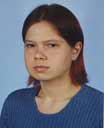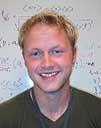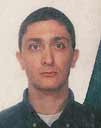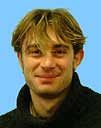Alexandre PASTSYAK
Institute for Nuclear Research, Moscow
alpas@zuzino.net.ru

I'm working on ISTRA setup in Protvino, this detector has been desined for searching rare Kaon decays. I have done computer modeling of this setup, and now take part in data analysis. I'm trying to investigate K->e,nu,gamma decay and to measure the form-factors of this decay. From the hardware side I'm engaged with the work of monitoring the perfomance of the ISTRA-setup. This includes development of the monitoring software and data analysis.
Mitesh PATEL
Cambridge University
patel@hep.phy.cam.ac.uk

For my PhD thesis I am working on NA48, the CERN CP violation experiment. NA48 will make measurements of very rare KS decays in 2002. My main interest is to discover the decay KS->pi0e+e-. I have studied the substantial backgrounds to this decay and have been developing an analysis which will eliminate them. If the KS->pi0e+e- branching ratio is at the predicted level of 5*10^-9, our control of the backgrounds should be sufficient to allow the first observation of this decay. In the meantime I am analysing data from our 2001 run which will allow us to tighten our current published limit in this channel. This decay mode is theoretically interesting as it can be used to bound the indirect CP violating component of the decay KL->pi0e+e-. On the hardware side I have helped test and maintain the muon counters of NA48 and I have also worked on the recently rebuilt drift chambers. I performed cosmic ray tests to certify the correct operation of the chambers and measured their detection efficiencies, as well as evaluating the performance of modified preamplifier electronics.
Thilo PAULY
University of Oxford
t.pauly1@physics.ox.ac.uk

The CDF experiment at Fermilab is the first detector at a proton collider which triggers on tracks displaced from the primary vertex. These tracks come mainly from heavy flavour decays, enabling CDF to collect the largest sample of fully reconstructed hadronic B decays. Such decays give a very good lifetime resolution, leading to a good potential for the first measurement of the oscillation frequency and lifetime difference of Bs mesons. For my PhD I am working mainly on the Bs reconstruction. On the other hand I investigate strategies for electron and muon triggers with displaced track pairs for selecting a high purity sample of tagged Bs decays.
Katarzyna PERL
Institute of Experimental Physics, Warsaw University
Katarzyna.Perl@fuw.edu.pl

Troels PETERSEN
Laboratoire de l'Accélérateur Linéaire, Université de Paris-Sud
petersen@slac.stanford.edu

I work on my Ph.D. at the BaBar experiment, an asymmetric e+e- B-factory at SLAC. I have previously worked on the measurement of sin(2beta), more specifically the fitting methods for this analysis (extraction of sin(2beta) and determination of the detector response for B-tagging) I now work on the more challeging measurement of the angle gamma. The channels considered are B0 --> D+- Ks pi-+ and B+- --> D0 K+- pi0, which exploit the same basic idea, but are very different both in reconstruction and analysis. I work both on the phenomenology of these decay channel (two separate papers are in preparation), and the actual analysis of obtaining a clean sample. In addition I'm involved in fitting the CKM matrix parameters. Regarding work on the detector, I'm one of the commissioners for the PID system of BaBar.
Fabrizio PETRUCCI
Universita' degli Studi di "Roma Tre"
petrucci@fis.uniroma3.it

The work done for my diploma thesis in physics (1999) and during the first two years of my Ph.D. (2000-2001) concernes the ATLAS experiment at the LHC. During 1999 I worked on the simulation of the level-2 muon trigger studyng the feasibility and reliability of an algorithm which revealed to be adequated to our purposes. In the last two years I have worked on the assembly and performance study of the MDT precision chambers for the muon spectrometer and on the construction of a cosmic-ray test site for these chambers. I have taken part in equipping the chambers with the gas and high voltage distribution; I have worked on the set-up of the read-out electronics and the acquisition software for the MDTís both in the test stand in Roma Tre and in a test beam at CERN. Now Iím also involved in the study of the autocalibration and of the chamber response and in the test of the calibration procedures with a detailed simulation of the detector.
Sergey PETRUSHANKO
Moscow State University
sergant@lav01.sinp.msu.ru

I'm a post-graduate student of the Physics Department of the Moscow State University. I investigates different processes in the heavy-ion collisions in the CMS detector of the LHC. The main field of my investigation is the computer simulation of such kind events and developing some methods to reconstruct their in CMS detector. I developed algotithmes of the reconstruction of the impact parameter, azimuthal angle plane, Z-coordinate and so on in heavy-ion collisions in CMS. I visited CERN five times (9.7.98--7.9.98, 3.12.99--17.12.99, 19.9.00--19.10.00, 3.7.01-3.8.01, 22.11.01--9.12.01). I presented my talks on the meetings during the CMS Weeks. I have 10 publications (CMS Notes, Eur.Phys.J., Phys.Part.Nucl.Letters etc).
Lidia PIERI
Universita' di Roma Tre
Dipartimento di Fisica "Edoardo Am
pieri@fis.uniroma3.it

For my Ph.D. thesis I am working in the cosmic ray experiment ARGO-YBJ in Tibet, where I am developing a method to measure the diffuse gamma-ray background from outside and inside the galaxy. I am also studying the possibility to use this measurement for an indirect search of dark matter. In parallel, I am going on with developments from my Diploma thesis in DELPHI (LEP). I am involved in the four-fermion working group measuring Zgamma* intermediate states processes. I use results from these analises to put limits on New Physics deriving from anomalous neutral triple gauge bosons coupling.
Federico PILO
University of Siena
federico.pilo@pi.infn.it

For my Ph.D. thesis I am working on AMS-02, a cosmic ray experiment which will be installed on the International Space Station in 2005. AMS-02 has been thought to measure the Antimatter abundance and study the Dark Matter nature. During the last two years I have been involved in the costruction of the elettromagnetic calorimeter, testing electronics, photomultipliers and materials that will have to work in extreme condition in Space. Now I am working on the analysis of the last Test Beam data, performing a new calibration procedure. From the hardware side, I am engaged in the realization of the DAQ system for the next Test Beam at CERN.
Freddy POIRIER
Royal Holloway, University of London
f.poirier@rhul.ac.uk

The major project in my PhD thesis is devoted to the Future Linear Collider (FLC) which is currently proposed as the next important high-energy experiment after the LHC. The FLC will collide electrons with positrons at center of mass energies on the TeV scale. I am involved with the luminosity calorimeter simulation using energy deposit from Bhabha scattering. This is particularly important as the results have a non-negligible effect on precision measurements on new physics processes, such as supersymmetry upon which I will focus later in my project. My present work includes development of lead-tungstate detector and beam diagnostic tools such as laser-wire sub-system as well as geometry description software, such as XML.
Michael PROUZA
Center for Particle Physics Czech Academy of Sciences, Praha
prouza@fzu.cz

My Ph.D. thesis, which is originating in the frame of the Pierre Auger collaboration, is partly based on my diploma thesis, in which I was analyzing the propagation of ultra-high energy cosmic rays in the Galactic magnetic field. Actually, I'm trying to connect these simulations of propagation of UHE cosmic rays with simulations of their behaviour in the vicinity of the possible sources. I'm now focusing on the pulsar reconnection models in collaboration with prof. Olinto from University of Chicago. Furthermore, in January 2002 I started the analysis of the background data files from prototype fluorescence detector of southern Auger array, Argentina. I'm analyzing positions and intensities of the star images projected on the individual phototubes. As the results of this analysis I plan to obtain the precise corrections of the fluorescence telescope alignment and the independent estimates of the absolute phototube gain and phototube linearity.